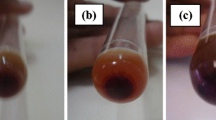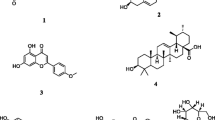Abstract
Marigold (Tagets erecta L.), being an ornamental plant, posses medicinal properties like antimicrobial, insecticidal, wound healing and blood coagulation properties. Our recent works mainly focus on blood clotting activity of marigold leaf extracts. Blood clotting activity of leaf extract was examined using prothrombin time (PT) test by Owren method. The optimization of marigold leaf coagulating activity at different concentration of leaf extract and blood was done with Response surface method (RSM). Experiments showed that there was decrease in coagulation time with increase in extract concentration. Marigold leaves extract has shown very good blood coagulation property in lesser quantity i.e., in the range of μl. Also, phenolic compounds (like gallic acid, scopoletin, ferulic acid, quercecetin) were identified and quantified, which shows that because of presence of them, marigold leaf extract shows coagulation property. Antifungal, antibacterial and antioxidant activity are also analyzed. From the above findings, it can be concluded that along with antibacterial, antifungal and antioxidant properties, marigold leave extracts are also having very good coagulation property; so, in further research it can be developed as an antiseptic with coagulation property and can be developed as a potent product in the field of medicine and ointment.

The overall diagrammatic representation of this experimental work



Similar content being viewed by others
References
Alicja U, Małgorzata S, Marcin M (2013) Theoretical investigation of stereochemistry and solvent influence on antioxidant activity of ferulic acid. Comput Theor Chem 1012:33–40
Biswas FB, Roy TG, Rahman A, Emran TB (2014) An in vitro antibacterial and antifungal effects of cadmium(II) complexes of hexamethyltetraazacyclotetradecadiene and isomers of its saturated analogue. Asian Pac J Trop Med 7:S534–S539
Canan T, Hande G, Figen T (2006) Optimization of a growth medium using a statistical approach for the production of analkaline protease from a newly isolated Bacillus sp.L21. Process Biochem 41:659–665
Ceriello A, Taboga C, Giacomello R, Falleti E, Stasio GD, Motz E, Lizzio S, Gonano F, Bartoli E (1994) Fibrinogen plasma levels as a marker of thrombin activation in diabetes. Diabetes 43:430–432
Dacie JV, Lewis SM (1995) Practical haematology, 8th edn. Churchill Livingstone, Edinburgh, p 305
Dasgupta N, Ranjan S, Saleh MAAM, Pradeep SJ, Samuel SM, Harris AD, Roy AC, Chidambaram R (2014) Extraction-based blood coagulation activity of marigold leaf: a comparative study. Comp Clin Pathol 23:1715–1718
Dasgupta N, Ranjan S, Shraddha M, Chidambaram R, Kumar A (2015a) Fabrication of food grade vitamin E nanoemulsion by low energy approach, characterization and its application. Int J Food Prop. doi:10.1080/10942912.2015.1042587
Dasgupta N, Shivendu R, Deepa M, Chidambaram R, Rishi S, Ashutosh K (2015b) Nanotechnology in agro-food: from field to plate. Food Res Int 69:381–400
Faizi S, Naz A (2004) Palmitoleate (=(9Z)-Hexadeca-9-enoate) esters of oleanane triterpenoids from the golden flowers of Tagetes erecta: isolation and autoxidation products. Helv Chim Acta 87:46–56
Fronza M, Heinzmann B, Hamburger M, Laufer S, Merfort I (2009) Determination of the wound healing effect of Calendula extracts using the scratch assay with 3 T3 fibroblasts. J Ethnopharmacol 126:463–467
Gargi D, Abhijit M, Rintu B, Maiti BR (2001) Enhanced production of amylase by optimization of nutritional constituents using response surface methodology. Biochem Eng 7:227–231
Gordana SC, Sonja MD, Jasna MC, Vesna TT (2004) Antioxidant properties of marigold extracts. Food Res Int 37:643–650
Green MM, Singer JM, Sutherland DJ, Hibben CR (1991) Larvicidal activity of Tagetes minuta (marigold) toward Aedesaegypti. J Am Mosq Control Assoc 7:282–286
Guder WG, Narayanan S, Wisser H, Zawta B (1997) Samples: from the patient to the laboratory, list of analytes preanalytical variables. Darmstadt, GITVERLAG GMBH, pp 28–52
Horsti J (2009) The progress of prothrombin time measurement. Hematol Rev 1, e19
Hsieh CL, Lin YC, Yen GC, Chen HY (2007) Preventive effects of guava (Psidium guajava L.) leaves and its active compounds against α-dicarbonyl compounds-induced blood coagulation. Food Chem 103:528–535
Jelena K, Višnja P, Silvana P, Pavel M, Ana Ć, Dejan S, Marina S (2008) Antioxidant and antimicrobial activity of Cynaracardunculus extracts. Food Chem 107:861–868
Kingsley JD, Shivendu R, Nandita D, Proud S (2013) Nanotechnology for tissue engineering: need, techniques and applications. J Pharm Res 7:200–204
Kwaan HC (1992) Changes in blood coagulation, platelet function, and plasminogen-plasmin system in diabetes. Diabetes 41:32–35
Madalena L, Anabela B, Joana T, Paula A, Filipe M, Luís M, Manuel S (2014) The effects of ferulic and salicylic acids on Bacillus cereus and Pseudomonas fluorescens single- and dual-species biofilms. Int Biodeter & Biodegr 86:42–51
Maddineni S, Badal KM, Shivendu R, Nandita D (2015) Diastase assisted green synthesis of sizecontrollable gold nanoparticles. RSC Adv. doi:10.1039/c5ra03117f
Maria TG, Serena F, Eleonora G, Gabriela M, Lucia B, Giovanni N, Lambusta D, Saso L (2002) Antimicrobial and anti-lipase activity of quercetin and its C2-C16 3-O-Acyl-Esters. Bioorg Med Chem 10:269–272
Matsubara K, Matsubara Y, Basic A, Liao ML, Hori K (2001) Anticoagulant properties of a sulfatedgalactan preparation from a marine green alga Codium cylindricum. Int J Biol Macromol 28:395–399
Nandita D, Shivendu R, Proud S, Rahul J, Swati M, Arabi MSMA (2012) Antibacterial activity of leaf extract of Mexican marigold (Tagetes erecta) against different gram positive and gram negative bacterial strains. J Pharm Res 5:4201–4203
Nandita D, Shivendu R, Bhavapriya R, Venkatraman M, Chidambaram R, Ganesh SA, Ashutosh K (2015) Thermal co-reduction approach to vary size of silver nanoparticle: its microbial and cellular toxicology. Environ Sci Pollut Res. doi:10.1007/s11356-015-4570-z
Oguwike FN, Onubueze DPM, Ughachukwu P (2013) Evaluation of activities of marigold extract on wound healing of albino Wister rat. IOSR J Dent Med Sc 8:67–70
Padma V, Suman K, Satyavati S (1997) Tagetes: a multipurpose plant. Bioresour Technol 62:29–35
Pawlaczyk I, Czerchawski L, Pilecki W, Lamer-Zarawska E, Gancarz R (2009) Polyphenolic-polysaccharide compounds from selected medicinal plants of Asteraceae and Rosaceae families: chemical characterization and blood anticoagulant activity. Carbohydr Polym 77:568–575
Pérez GRM, Luha HH, Garrido SH (2006) Antioxidant activity of Tagetes erecta essential oil. J Chil Chem Soc 51:883–886
Ranjan S, Amod K, Nandita D, Sathiavelu A, Ramalingam C (2014) Production of dextran using Leuconostoc mesenteroides NCIM-2198 and its media optimization by response surface methodology. J Pure App Microbiol 8:2359–2367
Rastogi NK, Rashmi KR (1999) Optimization of enzymatic liquification of mango pulp by response methodology. Eur Food Res Technol 209:57–62
Ravel R (1995) Clinical laboratory medicine, clinical application of laboratory data, 6th edn. St.Louis, Mosby, p 89
Roberto DG, Remigio LS, Elías OS, Héctor TA (2013) Comparative antibacterial effect of gallic acid and catechin against Helicobacter pylori. LWT Food Sci Technol 54:331–335
Sandipan C, Tigari P, Dupadahalli K, Nadendla RR, Divakar G (2011) Comparative efficacy of Tagetes erecta and Centella asiatica extracts on wound healing in albino rats. Chin Med 2:138–142
Sanyog J, Amit KJ, Milind P, Kaushik T (2013) Novel self-emulsifying formulation of quercetin for improved in vivo antioxidant potential: implications for drug-induced cardiotoxicity and nephrotoxicity. Free Radic Biol Med 65:117–130
Shivani R, Ramandeep S, Preeti T, Satinder K, Alok S (2011) Wound healing agents from medicinal plants: a review. Asian Pac JTrop Biomed 2:S1910–S1917
Shivendu R, Nandita D, Proud S (2012) Time dependent and spectrophotometric analysis of blood clotting property of marigold leaf extract and comparative study of its antibacterial activity. J Biotechnol Biomater 2:276
Shivendu R, Nandita D, Roy AC, Samuel SM, Ramalingam C, Shanker R, Kumar A (2014) Nanoscience and nanotechnologies in food industries: opportunities and research trends. J Nanoparticle Res 16(6):1–23. doi:10.1007/s11051-014-2464-5
Tietz NW (1995) Clinical guide to laboratory test, 3rd edn. W.B. Saunders company, Piladelphia, p 526
Vanaja N, Ramalingam C, Nandita D, Shivendu R, Rose LV, Kumar MS (2014) Optimization of growth medium using a statistical approach for the production of plant gallic acid from a newly isolated Aspergillus tubingenesis NJA-1. J Pure App Microbiol 8:3313–3324
Vilapakkam RP, Ponnian SMP, Ramesh K, Jemmi S (2011) Antihyperglycaemic, antilipidperoxidative and antioxidant effects of gallic acid on streptozotocin induced diabetic Wistar rats. Eur J Pharmacol 650:465–471
Wang BH, Ou-Yang JP (2005) Pharmacological actions of sodium ferulate in cardiovascular system. Cardiovasc Drug Rev 23:161–172
Wang M, Tsao R, Zhang S, Dong Z, Yang R, Gong J, Pei Y (2006) Antioxidant activity, mutagenicity/anti-mutagenicity, and clastogenicity/anti-clastogenicity of lutein from marigold flowers. Food Chem Toxicol 44:1522–1529
Winocour PD (1994) Platelets, vascular disease, and diabetes mellitus. Can J Physiol Pharmacol 72:295–303
XpertArena (2015) Few major ornamental plants found in India and their applications. website: www.xpertarena.com (Retrieved on 15th February 2015)
Yin ZZ (1980) The effect of dong quai (Angelica sinsis) and its ingredient ferulic acid on rat platelet aggregation and release of 5-HT. Acta Pharm Sin 15:321–330
Yoon SJ, Yu MA, Pyun YR, Hwang JK, Chu DC, Juneja LR, Mourão PA (2003) The nontoxic mushroom Auricularia auricula contains a polysaccharide with anticoagulant activity mediated by antithrombin. Thromb Res 112:151–158
Zitterl-Eglseer K, Sosa S, Jurenitsch J, Schubert-Zsilavecz M, Della LR, Tubaro A, Bertoldi M, Franz C (1997) Anti-oedematous activities of the main triterpendiol esters of marigold (Calendula officinalis L.). J Ethnopharmacol 57:139–144
Acknowledgments
SR and ND are acknowledging Mrs. Maya Majumdar, Lucknow, India for giving the basic idea about the medicinal properties of marigold. Authors are acknowledging Jai Prakash University, Chapra, Bihar, India for providing technical support to carry out the work. Authors are acknowledging the partial funding provided by Veer Kunwar Singh Memorial Trust, Chapra, Bihar, India to complete this project-VKSMT/SN/NFNA/0011. Authors are acknowledging Department of Biotechnology (DBT, India) for the funding with grant number – BT/PR10414/PFN/20/961/2014.
Author information
Authors and Affiliations
Corresponding authors
Ethics declarations
Ethical statements
The authors received ethical clearance (as needed) from Veer Kunwar Singh Memorial Trust, Chapra, India with the reference number VKSMNT/SN/2015/RES/03.
Conflicts of Interest
Authors are declaring no conflict of interest.
Additional information
Nandita Dasgupta and Shivendu Ranjan contributed equally to this work.
Rights and permissions
About this article
Cite this article
Dasgupta, N., Ranjan, S., Shree, M. et al. Blood coagulating effect of marigold (Tagetes erecta L.) leaf and its bioactive compounds. Orient Pharm Exp Med 16, 67–75 (2016). https://doi.org/10.1007/s13596-015-0200-z
Received:
Accepted:
Published:
Issue Date:
DOI: https://doi.org/10.1007/s13596-015-0200-z




